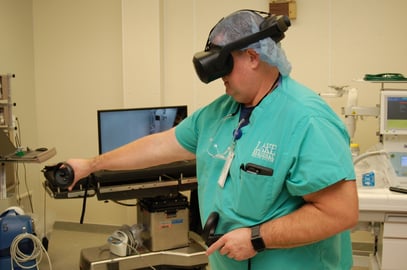We had the privilege of conversing with Alvin Lawson, CSFA, Surgical Services Education Coordinator, and Perioperative Educator at Lake Regional Health System. With a remarkable background in surgical technology dating back to 1991 and certification as a Surgical First Assistant in 2002, Alvin is at the forefront of surgical education.
Supported by the unwavering dedication of Director of Peri-Operative Services Sarah Green, they've embarked on a groundbreaking journey into the realm of Virtual Reality Simulation training, reshaping the landscape of surgical education. As Alvin shared invaluable insights, we spotlight the pivotal role of PeriopSim VR in their pursuit of surgical excellence. Join us as we delve into this captivating narrative of transformation and learning in the realm of healthcare.
According to Alvin, PeriopSim VR seamlessly integrated into their training process, allowing everyone to use the VR headset. He emphasizes, "Everyone has had the opportunity to utilize the VR headset." They even incorporated a television, using screen casting, facilitating collaboration among Learners who could observe what their peers were experiencing in the VR headset.
Additionally, tablets were used to enhance training, maximizing available time. They spent approximately 23 hours in simulation, equivalent to about 140 hours of real-time learning. Alvin mentioned, "We also use tablets and VR training when we confirm cases for the next day and need to prepare instrument sets. Sometimes we get to work in the room." This approach has allowed them to prepare instrument sets for upcoming procedures and refresh the skills of team members.
Learner Profiles and PeriopSim Advantages
Alvin explains how PeriopSim VR caters to users of all experience levels, allowing them to easily access the platform at their convenience. The impact of VR training is particularly striking for newcomers, with all Learners who recently started showing great progress. Even those from sterile processing find VR indispensable for instrument recognition and procedural comprehension. Alvin highlights how VR develops muscle memory and anticipatory skills as Learners focus on the surgeon's movements, finding instruments, and preparing for the next step.
In addition, Alvin highlights the advantages of using PeriopSim VR for Learners' profiles. He further explains that the immersive VR environment not only helps Learners understand and anticipate procedures but also dynamically fine-tunes their skills stating, "By repetition, their knowledge gets reinforced, they understand it, and everybody's safe in the long run." Alvin emphasizes that VR ensures consistent and precise instrument passing, with Learners practicing the same exchange patterns throughout procedures. It also highlights the adaptability and comprehensive nature of PeriopSim VR for those aspiring to join the CVOR team.
Furthermore, Learners first familiarize themselves with locating items in the virtual surgical environment, gradually learning to recognize instrumentation before engaging in VR experiences. This comprehensive approach enhances knowledge retention and progress assessment, unlike real-life scenarios where details are often forgotten when moving from one case to the next. In the VR environment, Learners can complete multiple procedures, reinforcing their knowledge more effectively in less time.

Instrument Names:
Alvin keeps a detailed list of instruments, including names, uses, and alternative terms. This helps Learners become familiar with the instruments used in their facility, including those with non-standard nicknames.
Alvin's dedication to detail extends to nursing students and demonstrates the versatility of PeriopSim VR as an educational tool. It impacts both professionals and aspiring healthcare students, showcasing its adaptability and effectiveness in teaching instrument recognition and procedural understanding. This commitment to surgical excellence mirrors the dedication of professionals like Alvin, highlighting how innovative solutions like PeriopSim VR transform surgical training.
Conclusion Remarks
PeriopSim VR's ability to provide limitless practice opportunities reduces stress and anxiety for Learners.
In his Educator role, Alvin appreciates how PeriopSim VR optimizes training efficiency, allowing him to oversee multiple Learners. He eagerly anticipates the addition of more cases to the library, reinforcing the transformative role of PeriopSim VR in surgical education. It ensures healthcare professionals are well-prepared, confident, and competent, benefitting Learners and patients alike. PeriopSim VR is paving the way for the future of healthcare education.